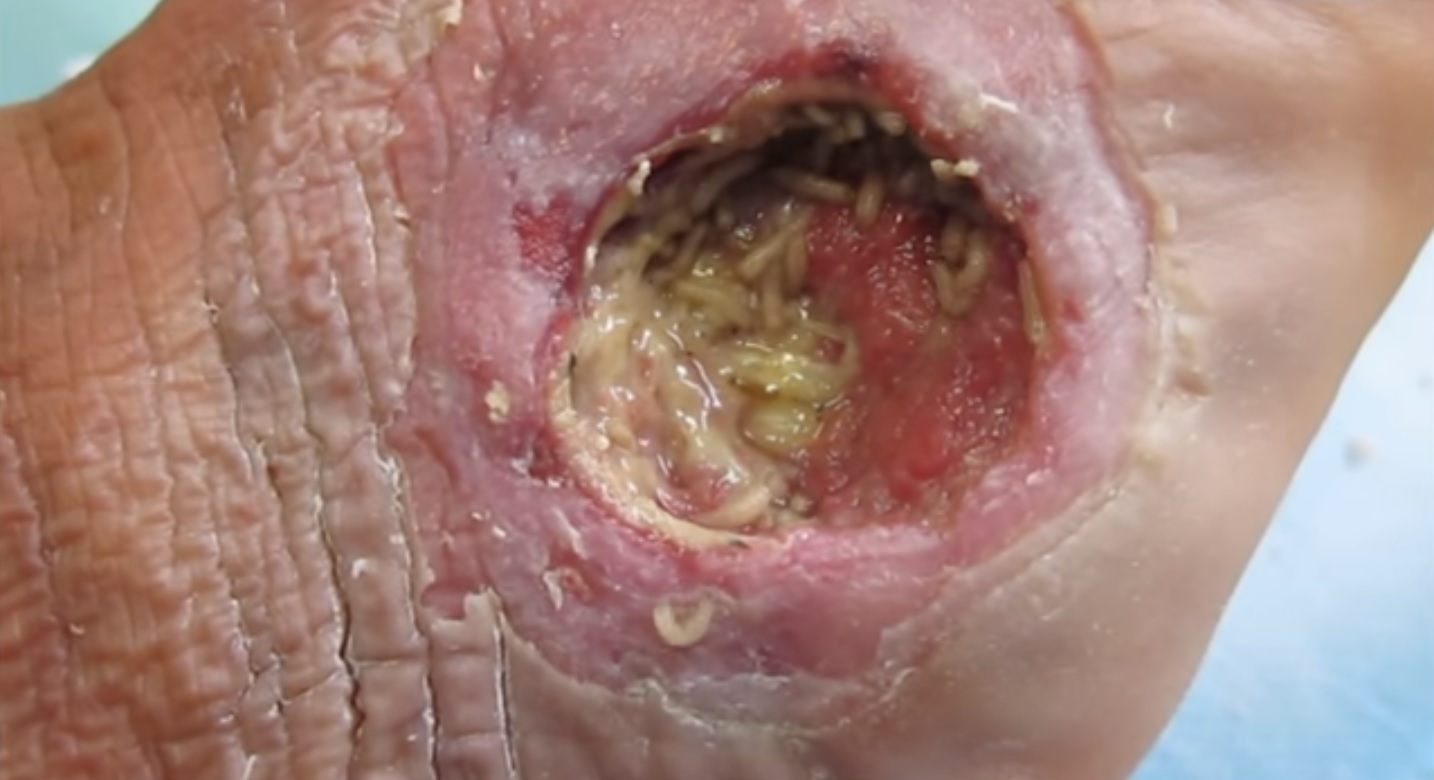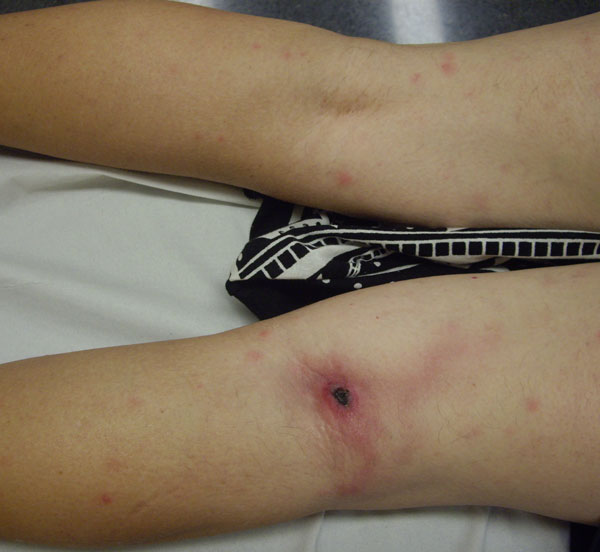|
Surgical Debridement
Debridement is the medical removal of dead, damaged, or infected tissue to improve the healing potential of the remaining healthy tissue. Removal may be surgical, mechanical, chemical, autolytic (self-digestion), and by maggot therapy. In podiatry, practitioners such as chiropodists, podiatrists and foot health practitioners remove conditions such as calluses and verrucas. Debridement is an important part of the healing process for burns and other serious wounds; it is also used for treating some kinds of snake and spider bites. Sometimes the boundaries of the problem tissue may not be clearly defined. For example, when excising a tumor, there may be micrometastases along the edges of the tumor that are too small to be detected, but if not removed, could cause a relapse. In such circumstances, a surgeon may opt to debride a portion of the surrounding healthy tissue to ensure that the tumor is completely removed. Types There is lack of high quality evidence to compare the ... [...More Info...] [...Related Items...] OR: [Wikipedia] [Google] [Baidu] |
Necrosis
Necrosis () is a form of cell injury which results in the premature death of cells in living tissue by autolysis. Necrosis is caused by factors external to the cell or tissue, such as infection, or trauma which result in the unregulated digestion of cell components. In contrast, apoptosis is a naturally occurring programmed and targeted cause of cellular death. While apoptosis often provides beneficial effects to the organism, necrosis is almost always detrimental and can be fatal. Cellular death due to necrosis does not follow the apoptotic signal transduction pathway, but rather various receptors are activated and result in the loss of cell membrane integrity and an uncontrolled release of products of cell death into the extracellular space. This initiates in the surrounding tissue an inflammatory response, which attracts leukocytes and nearby phagocytes which eliminate the dead cells by phagocytosis. However, microbial damaging substances released by leukocytes would crea ... [...More Info...] [...Related Items...] OR: [Wikipedia] [Google] [Baidu] |
Eschar
An eschar (; Greek: ''ἐσχάρᾱ'', ''eskhara''; Latin: ''eschara'') is a slough or piece of dead tissue that is cast off from the surface of the skin, particularly after a burn injury, but also seen in gangrene, ulcer, fungal infections, necrotizing spider bite wounds, tick bites associated with spotted fevers and exposure to cutaneous anthrax. The term ‘eschar’ is not interchangeable with ‘scab’. An eschar contains necrotic tissue whereas a scab is composed of dried blood and exudate. Black eschars are most frequently attributed in medicine to cutaneous anthrax (infection by '' Bacillus anthracis''), which may be contracted through herd animal exposure and also from ''Pasteurella multocida'' exposure in cats and rabbits. A newly identified human rickettsial infection, ''R. parkeri'' rickettsiosis, can be differentiated from Rocky Mountain spotted fever by the presence of an eschar at the site of inoculation. Eschar is sometimes called a ''black wound'' becau ... [...More Info...] [...Related Items...] OR: [Wikipedia] [Google] [Baidu] |
ABIM Foundation
Choosing Wisely is a United States-based health educational campaign, led by the ABIM Foundation (American Board of Internal Medicine), about unnecessary health care. The campaign identifies over 500 tests and procedures and encourages doctors and patients to discuss, research, and possibly get second opinions, before proceeding with them. To conduct the campaign, the ABIM Foundation asks medical specialty societies to make five to ten recommendations for preventing overuse of a treatment in their field. The foundation then publicizes this information, and the medical specialty societies disseminate it to their members. The campaign has garnered both praise and criticism, and some of its ideas have spread to other countries. It does not include evaluation of its effects on costs, on discussions or on medical outcomes. Some doctors have said they lack time for the recommended discussions. History In 2002 the ABIM Foundation published ''Medical professionalism in the new millenni ... [...More Info...] [...Related Items...] OR: [Wikipedia] [Google] [Baidu] |
Hydrotherapy
Hydrotherapy, formerly called hydropathy and also called water cure, is a branch of alternative medicine (particularly naturopathy), occupational therapy, and physiotherapy, that involves the use of water for pain relief and treatment. The term encompasses a broad range of approaches and therapeutic methods that take advantage of the physical properties of water, such as temperature and pressure, to stimulate blood circulation, and treat the symptoms of certain diseases. Various therapies used in the present-day hydrotherapy employ water jets, underwater massage and mineral baths (e.g. balneotherapy, Iodine-Grine therapy, Kneipp treatments, Scotch hose, Swiss shower, thalassotherapy) or whirlpool bath, hot Roman bath, hot tub, Jacuzzi, and cold plunge. Uses Water therapy may be restricted to use as aquatic therapy, a form of physical therapy, and as a cleansing agent. However, it is also used as a medium for delivery of heat and cold to the body, which has long been the b ... [...More Info...] [...Related Items...] OR: [Wikipedia] [Google] [Baidu] |
Tissue (biology)
In biology, tissue is a biological organizational level between cells and a complete organ. A tissue is an ensemble of similar cells and their extracellular matrix from the same origin that together carry out a specific function. Organs are then formed by the functional grouping together of multiple tissues. The English word "tissue" derives from the French word "tissu", the past participle of the verb tisser, "to weave". The study of tissues is known as histology or, in connection with disease, as histopathology. Xavier Bichat is considered as the "Father of Histology". Plant histology is studied in both plant anatomy and physiology. The classical tools for studying tissues are the paraffin block in which tissue is embedded and then sectioned, the histological stain, and the optical microscope. Developments in electron microscopy, immunofluorescence, and the use of frozen tissue-sections have enhanced the detail that can be observed in tissues. With these tools, the c ... [...More Info...] [...Related Items...] OR: [Wikipedia] [Google] [Baidu] |
Medical Journal Armed Forces India
''Medical Journal Armed Forces India'' is a quarterly peer-reviewed medical journal covering all disciplines of medical science. It is published by Elsevier on behalf of the Armed Forces Medical Services of India and the editor-in-chief is Col Rakesh Datta. The journal was established in 1945 as ''Journal of Indian Army Medical Corps'', obtaining its current name in 1974. Abstracting and indexing The journal is abstracted and indexed in CAB Abstracts, Embase, and Scopus Scopus is Elsevier's abstract and citation database launched in 2004. Scopus covers nearly 36,377 titles (22,794 active titles and 13,583 inactive titles) from approximately 11,678 publishers, of which 34,346 are peer-reviewed journals in top-l .... References External links *{{Official website, http://afmc.nic.in/Departments/MJAFI/homepage.html General medical journals Quarterly journals Indian Army Publications established in 1945 English-language journals ... [...More Info...] [...Related Items...] OR: [Wikipedia] [Google] [Baidu] |
Bromelain
Bromelain is an enzyme extract derived from the stems of pineapples, although it exists in all parts of the fresh pineapple. The extract has a history of folk medicine use. As an ingredient, it is used in cosmetics, as a topical medication, and as a meat tenderizer. The term "bromelain" may refer to either of two protease enzymes extracted from the plants of the family Bromeliaceae, or it may refer to a combination of those enzymes along with other compounds produced in an extract. Bromelain enzymes are called ''fruit bromelain'' and ''stem bromelain''. Although tested in a variety of folk medicine and research models for its possible efficacy against diseases, bromelain has only one approved clinical application issued in 2012 by the European Medicines Agency a topical medication called ''NexoBrid'', used to remove dead tissue in severe skin burns. Extract components Bromelain extract is a mixture of protein-digesting (proteolytic) enzymes and several other substances in smal ... [...More Info...] [...Related Items...] OR: [Wikipedia] [Google] [Baidu] |
Papain
Papain, also known as papaya proteinase I, is a cysteine protease () enzyme present in papaya (''Carica papaya'') and mountain papaya (''Vasconcellea cundinamarcensis''). It is the namesake member of the papain-like protease family. It has wide ranging commercial applications in the leather, cosmetic, textiles, detergents, food and pharmaceutical industries. In the food industry, papain is used as an active ingredient in many commercial meat tenderizers. Papain family Papain belongs to a family of related proteins, known as the papain-like protease family, with a wide variety of activities, including endopeptidases, aminopeptidases, dipeptidyl peptidases and enzymes with both exo- and endopeptidase activity. Members of the papain family are widespread, found in Baculoviridae, baculoviruses, eubacteria, yeast, and practically all protozoa, plants and mammals. The proteins are typically lysosomal or secreted, and proteolytic cleavage of the propeptide is required for enzyme activa ... [...More Info...] [...Related Items...] OR: [Wikipedia] [Google] [Baidu] |
Varidase
Streptokinase (SK) is a thrombolytic medication activating plasminogen by nonenzymatic mechanism. As a medication it is used to break down clots in some cases of myocardial infarction (heart attack), pulmonary embolism, and arterial thromboembolism. The type of heart attack it is used in is an ST elevation myocardial infarction (STEMI). It is given by injection into a vein. Side effects include nausea, bleeding, low blood pressure, and allergic reactions. A second use in a person's lifetime is not recommended. While no harm has been found with use in pregnancy, it has not been well studied in this group. Streptokinase is in the antithrombotic family of medications and works by turning on the fibrinolytic system. Streptokinase was discovered in 1933 from beta-hemolytic streptococci. It is on the World Health Organization's List of Essential Medicines. It is no longer commercially available in the United States. Medical uses If percutaneous coronary intervention (PCI) is not a ... [...More Info...] [...Related Items...] OR: [Wikipedia] [Google] [Baidu] |






